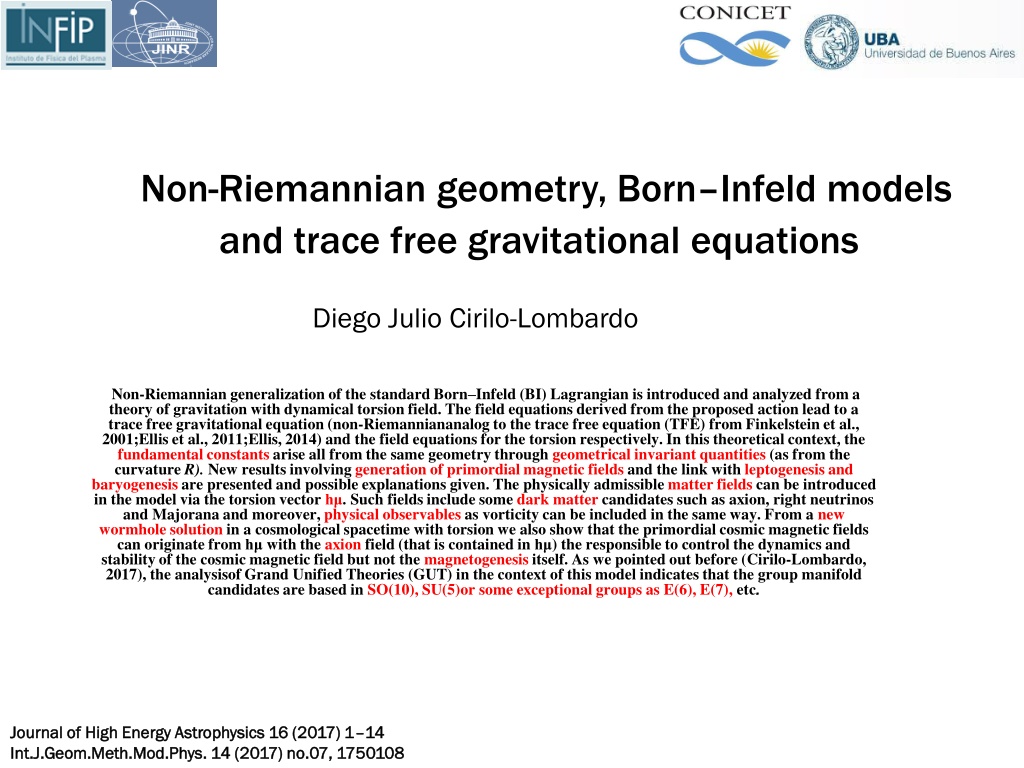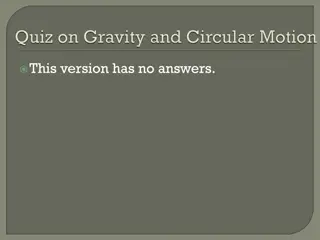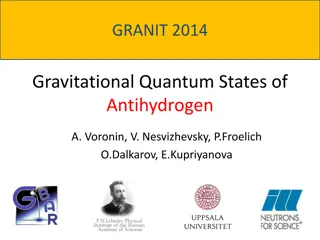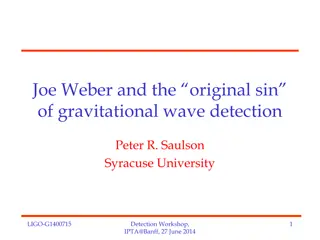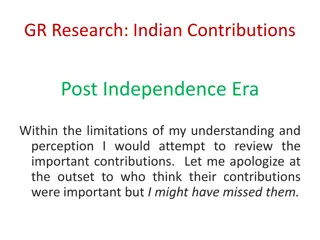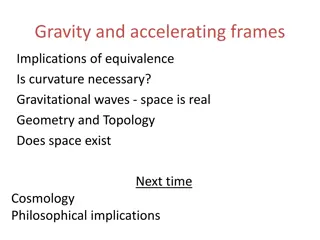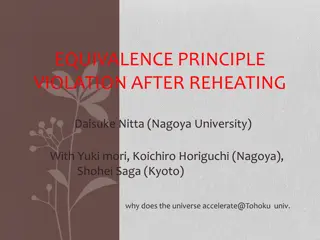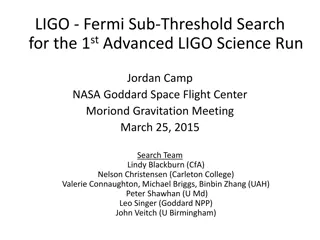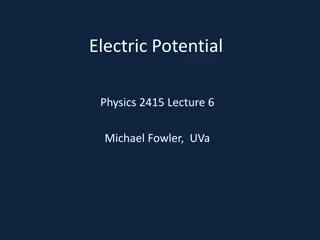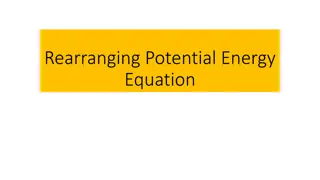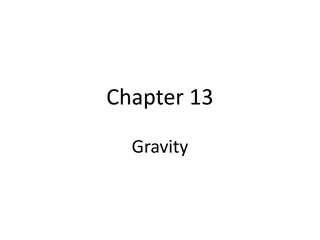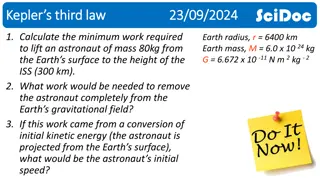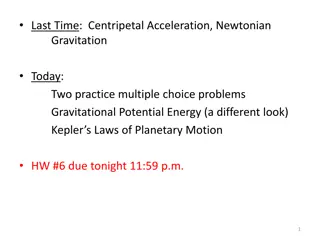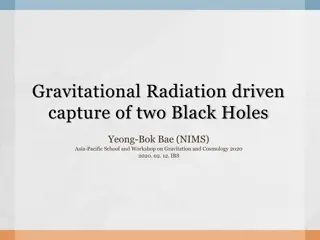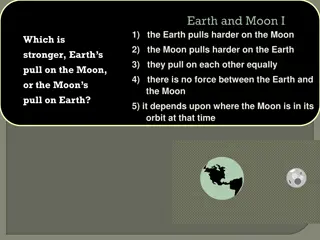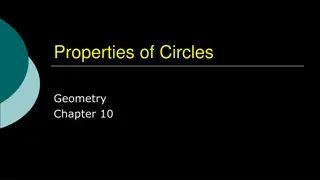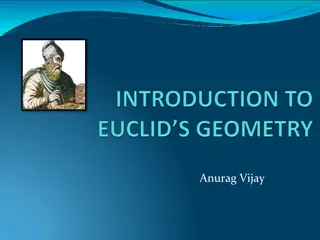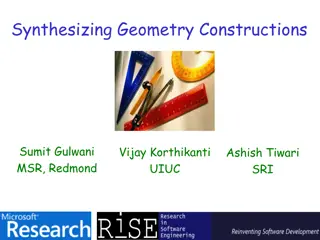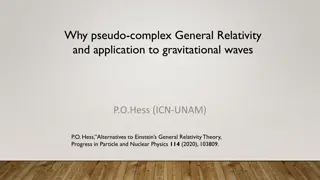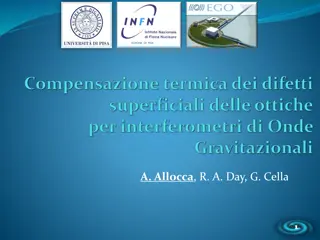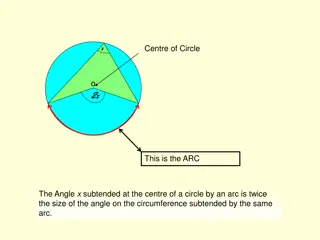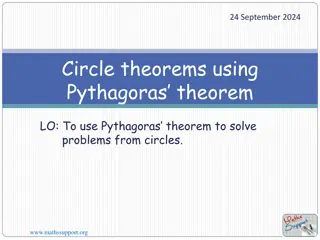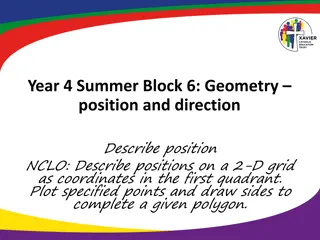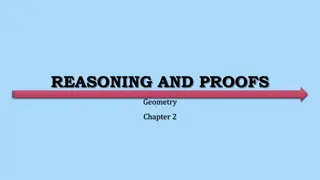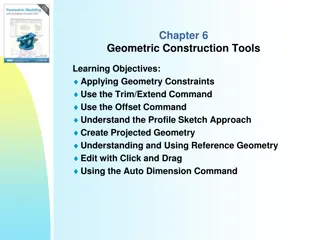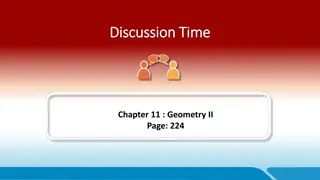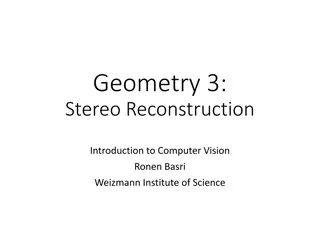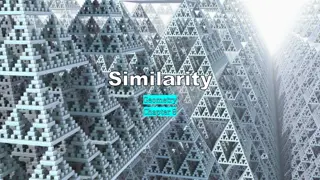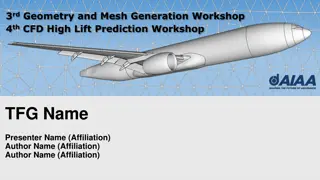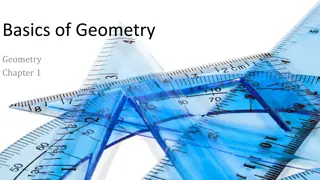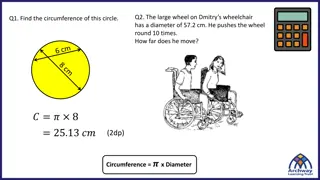Non-Riemannian Geometry and Born-Infeld Models in Gravitational Theory
In this paper by Diego Julio Cirilo-Lombardo, a non-Riemannian generalization of the Born-Infeld Lagrangian is introduced in the context of gravitation with a dynamical torsion field. The resulting field equations lead to a trace-free gravitational equation and provide insights into primordial magnetic fields, leptogenesis, baryogenesis, and dark matter candidates. The model also explores Grand Unified Theories based on group manifolds such as SO(10), SU(5), E(6), E(7), among others. The study discusses the implications of emergent trace-free gravitational equations, the constancy of fundamental constants, and the role of torsion in controlling cosmic magnetic fields.
Download Presentation

Please find below an Image/Link to download the presentation.
The content on the website is provided AS IS for your information and personal use only. It may not be sold, licensed, or shared on other websites without obtaining consent from the author. Download presentation by click this link. If you encounter any issues during the download, it is possible that the publisher has removed the file from their server.
E N D
Presentation Transcript
Non-Riemannian geometry, BornInfeld models and trace free gravitational equations Diego Julio Cirilo-Lombardo Non-Riemannian generalization of the standard Born Infeld (BI) Lagrangian is introduced and analyzed from a theory of gravitation with dynamical torsion field. The field equations derived from the proposed action lead to a trace free gravitational equation (non-Riemanniananalog to the trace free equation (TFE) from Finkelstein et al., 2001;Ellis et al., 2011;Ellis, 2014) and the field equations for the torsion respectively. In this theoretical context, the fundamental constants arise all from the same geometry through geometrical invariant quantities (as from the curvature R). New results involving generation of primordial magnetic fields and the link with leptogenesis and baryogenesis are presented and possible explanations given. The physically admissible matter fields can be introduced in the model via the torsion vector h . Such fields include some dark matter candidates such as axion, right neutrinos and Majorana and moreover, physical observables as vorticity can be included in the same way. From a new wormhole solution in a cosmological spacetime with torsion we also show that the primordial cosmic magnetic fields can originate from h with the axion field (that is contained in h ) the responsible to control the dynamics and stability of the cosmic magnetic field but not the magnetogenesis itself. As we pointed out before (Cirilo-Lombardo, 2017), the analysisof Grand Unified Theories (GUT) in the context of this model indicates that the group manifold candidates are based in SO(10), SU(5)or some exceptional groups as E(6), E(7), etc. . Journal of High Energy Astrophysics 16 (2017) 1 Journal of High Energy Astrophysics 16 (2017) 1 14 Int.J.Geom.Meth.Mod.Phys Int.J.Geom.Meth.Mod.Phys. 14 (2017) no.07, 1750108 . 14 (2017) no.07, 1750108 14
1. Introduction 2. Basis of the metrical-affine geometry 3. Geometrical Lagrangians: the generalized Born Infeld action 4. Field equations 5. Emergent trace free gravitational equations 6. On the constancy of G 7. The vector h and the energy matter interpretation 8. Physical consequences 9. Torsion, axion electrodynamics vs. Chern Simons theory 10. Magnetic helicity generation and cosmic torsion field 11. Discussion and perspectives
INTRODUCTION 1) The drawback of the Einstein GR (General Relativity) equations is the RHS: R g R/2 = T with the symmetric tensor (non-geometrical) T that introduces heuristically the energy momentum distribution 2) Similar troubles is obtained from Einstein Hilbert action in which the unimodular condition: detg =1 is also imposed from the very beginning The resulting field equations correspond to the trace-less Einstein equations and can be shown that they are equivalent to the full Einstein equations with the cosmological constant term , where enters as an integration constant and the equivalence between unimodular gravity and general relativity is given by the arbitrary value of lamda 3) The fact that the determinant of the metric is fixed has clearly profound consequences on the structure of given theory. First of all, it reduces the full group of diffeomorphisms to invariance under the group of unimodular general coordinate transformations which are transformations that leave the determinant of the metric unchanged.
4) Similar thing happens in the non-Riemannian case, where the corresponding affine geometrical structure induces naturally the following constraint: K/ g = constant. This natural constraint impose a condition (ratio) between both basic tensors through their determinants: the metric determinant g and the fundamental one K (in the sense of a nonsymmetric theory that contains the antisymmetric structures), independently of the precise functional form of K or g. 5) In this work our starting point was precisely the last one, where a metric affine structure in the space time manifold will be considered. We will also show that trace free gravitational equations can be naturally obtained when the Lagrangian function (geometrical action) is taken as a measure involving a particular combination of the fundamental tensors of the geometry: with the (0, 2) tensors g , f , R : the symmetric metric, the antisymmetric one (that acts as potential of the torsion field) and the generalized Ricci tensor (proper of the non-Riemannian geometry). 6) The three tensors are related with a Clifford structure of the tangent space where the explicit choice for f (g , f ,R ) is given 7) This type of Lagrangians, because are non-Riemannian generalizations of the well known Nambu Goto and Born Infeld (BI) ones, can be physically and geometrically analyzed. 8) Due the pure geometrical structure of the theory, induced energy momentum tensors and fundamental constants (actually functions) emerge naturally. 9) Consequently, this fact allows the physical realization of the Mach principle
METRICAL AFFINE GEOMETRY: BASICS The starting point is a hypercomplex construction of the (metric compatible) spacetime manifold (Cirilo-Lombardo, 2015;McInnes, 1984) where for each point p M there exists a local affine space A. The connection over A, , define a generalized affine connection on M, specified by ( ,K), where K is an invertible (1,1)tensor over M. We will demand for the connection to be compatible and rectilinear, that is where T is the torsion, and g space time metric (used to raise and lower the indices and determining the geodesics), that is preserved under parallel transport. This generalized compatibility condition ensures that the generalized affine connection maps autoparallels of on M into straight lines over the affine space A(locally). The first equation above is equal to the con-dition determining the connection in terms of the fundamental field in the UFTnon- symmetric. Hence, Kcan be identified with the fundamental tensor in the non-symmetric fundamental theory. This fact gives us the possibility to restrict the connection to a (anti-)Hermitian theory. The covariant derivative of a vector with respect to the gener-alized affine connection is given by The generalized compatibility condition (2)determines the 64components of the connection by the 64equations Notice that by contracting indices and in the first equation above, an additional condition over this hypothetical fundamental (nonsymmetric) tensor Kis obtained that, geometrically speaking, reads
METRICAL AFFINE GEOMETRY: BASICS The metric is uniquely determined by the metricity condition, which puts 40restrictions on the derivatives of the metric The space time curvature tensor, that is defined in the usual way, has two possible contractions: the Ricci tensor R , and the second contraction, which is identically zero due to the metricity condition (2). Kis uniquely specified by condition As it was pointed out in Cirilo-Lombardo (2010,2011a,2011b,2007,2013), inserting explicitly the torsion tensor as the antisym-metric part of the connection in (5 where K=detK . Notice that from expression (7)we arrive at the relation between the determinants Kand g: (strictly a constant scalar function of the coordinates). Now we can write as the first term of (7)is the derivative of a scalar. Then, the torsion tensor has the symmetry This implies that the trace of the torsion tensor, is the gradient of a scalar field In McInnes(1984)an interesting geometrical analysis is pre-sented of non-symmetric field structures. There, expressions pre-cisely as (1)and (2)ensure that the basic non-symmetric field structures (i.e.K) take on a definite geometrical meaning when interpreted in terms of affine geometry. Notice that the tensor K carries the 2-form (bivector) that will be associated with the fundamental antisymmetric form
Geometrical Lagrangians: the generalized Born Infeld action
Geometrical Lagrangians: the generalized Born Infeld action
If the induced structure from the tangent space Tp(M) (via Ambrose Singer theorem) is intrinsically related to a (super)manifold structure, we have seen that there exists a transformation (Weyl, 1952;Cirilo-Lombardo, 2015) (with A, B....generally a multi-index) having the same form as the blocks inside of the square root proposed Lagrangian (19) wherethe Poisson structure is evident (as the dual of the Lie algebra of the group manifold) in our case leading the identification between the group structure of the tan-gent space with the space time curvature as DJCL, DJCL, Int.J.Theor.Phys Int.J.Theor.Phys. 54 (2015) no.10, 3713 . 54 (2015) no.10, 3713- -3727 3727
Field equations The last principle is key because it states that the spinor invariance of the fundamental space- time structure should be derivable from the dynamic symmetries given by (21). The fact that the LG satisfies the 3 principles shows also that it has the simpler form. Notice that the action density proposed by Einstein in his nonsymmetric field theory satisfies i) and ii) but not iii).
1) The eq. (31) is trace-free type, consequently the trace of the third term of the above equation ( that is the cosmological one ) is equal to zero. This happens trivially if = 0 or 2) b takes the place of limiting parameter (maximum value) for the electromagnetic field strength. 3)b is not a constant in general, in sharp contrast with the Born-Infeld or string theory cases. 4) Because b is the ratio involving both curvature scalars from the contrac- tions of the generalized Ricci tensor: it is preponderant when the symmetrical contraction of R is greater than the skew one. 5) The fact pointed out in ii), namely that the curvature scalar plays the role as some limiting parameter of the field strength, was conjectured by (Mansouri 1976) in the context of gravity theory over group manifold (generally with symmetry breaking). In such a case, this limit was established after the explicit integration of the internal group- valuated variables that is not our case here.
6) In similar form that the Eddington conjecture: R() g, we have a condition over the ratios as follows: R( ) /Rs g / D 7) The equations are the simplest ones when ( =0), taking the exact quasilinear form this particular case (e.g. projective invariant) will be used through this work. Notice that when ( =0)all terms into the gravitational equation involving the pseudoscalar invariant,vanishes
EMERGENT TRACE FREE GRAVITATIONAL EQUATIONS
Tracing the first expression in (40) we have a link the value of the curvature and the norm of the torsion vector field. Consequently, if the dual of the torsion field have the role of the energy-matter carrier, the meaning of lambda as the vacuum energy is immediately established. Notice that the LHS in expression (40) instead to be proportional to the metric tensor it can be proportional to the square of a Killing-Yano tensor.
h and the energymatter interpretation the antisymmetric tensor A in the h composition is related with the Killing (Carter, 1968)and Killing Yano (Yano, 1952)systems. Consequently we can introduce two types of couplings into the A divergence: it correspond with the generalized cur-rent interpretation that also has h .
3+1 structure The above expression will be very important, in particular to discuss magnetogenesis and particle generation Notice the important fact that the symmetry of the vorticity can be associated to a 2-form bivector
Physical consequences A. Electrodynamic structure in 3+1 B. Dynamo effect and geometrical origin of term
D. Generalized current and -term
Magnetic helicity generation and cosmic torsion field We consider the projective invariant case: =0 (RA= 4 ) where the gravitational and field equations are considerably simplified .Scalar curvature R and the torsion 2-form field with a SU(2)-Yang Mills structure are defined in terms of the affine connection and the SU(2)valuated (structural torsion potential) From the last equation for the totally antisymmetric Torsion 2-form, the potential fa define the connection. Can be interpreted as a prototype of gauge theories interacting with gravity (e.g.QCD, GUTs, etc.). All the fundamental constants are really geometrically induced as required by the Mach principle.
the field equation for the torsion 2-form in differential form We are going to seek for a classical solution of (107)and (109)with the following ansatz for the metric and gauge connection
Magnetogenesis and cosmic helicity II In the case to include the complete alpha term given by equations and in the same analytical conditions (e.g.: Fourier de-composition) , the torsion- modified dynamic equations for the expanding FRW become where in this case the magnetic field is written (by convenience) in terms of complex variable zas
The solution in this case there are not a definite polarization for the magnetic field, :
Replacing explicitly hfrom the decomposition we can see, the interplay between the physical entities, The above expression it is very important because establishes the desired connection between helicities, magnetic field and fermionic fields and axion. We now clearly see the link between the axion and the fermionic fields (the dynamics of the interacting fields and the involved currents) in the LHS and the macroscopic physical observables in the RHS giving an indication of the origin of leptogenesis and baryoge-nesis in the context of this non-Riemannian gravitational model.
Phenomenological issues: axion mass limits Cirilo-Lombardo, D.J., 2013. Astropart. Phys. 50 52, 51. arXiv:1310.4924 ( Generalization of Bethe, H., 1935. Proc. Camb. Philol. Soc. 31, 108) The highest helicity spin-flip cross-sectional values presented in , Journal of High Energy Astrophysics 13 14 (2017) 10 16 coincide with a recent estimation on the axion mass computed in the framework of finite temperature extended lattice QCD and under cosmological considerations (Borsanyi, S., et al., 2016. Nature 539, 69. arXiv:1606.07494.)
DJCL, Alvarez-Castillo and Zamora Saa, Journal of High Energy Astrophysics 13 14 (2017) 10 16
Discussion and perspectives The functional action proposed, that is as square root or measure, the dynamic equations were derived: an equation analogous to trace free Einstein equations TFE and a dynamic equation for the torsion (which was taken totally antisymmetric). The physically admissible analysis of the torsion vector h , from the point of view of the symmetries, has allowed us to see how matter fields can be introduced in the model. These fields include some dark matter candidates such as axion, right neutrinos and Majorana. Also the vorticity can be included in the same way and, as the torsion vector is connected to the magnetic field, both vorticity and magnetic field can be treated with equal footing. The other point is that from the wormhole solution in a cosmological spacetime with torsion we show that primordial cosmic magnetic fields can be originated by the dual torsion field h being the axion field contained in h , the responsible to control the dynamics and stability of the cosmic magnetic field, but is not responsible of the magnetogenesis itself. Also the energy conditions in the wormhole solution are fulfilled. The last important point to highlight is that the dynamic torsion field h acts as mechanism of the reduction of an original (early, primordial) GUT (Grand Unified Theory) symmetry of the universe containing SU(3) SU(2)R SU(2)L U(1) to SU(3) SU(2)L U(1) today. Consequently, the GUT candidates are S O(10), SU(5) or some exceptional groups as E(6), E (7) for example.
